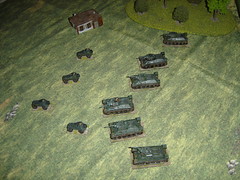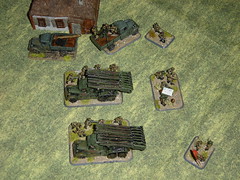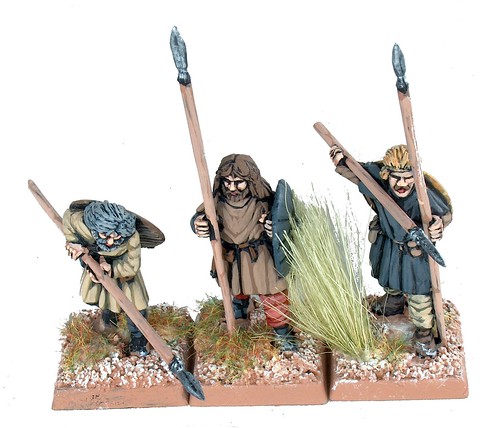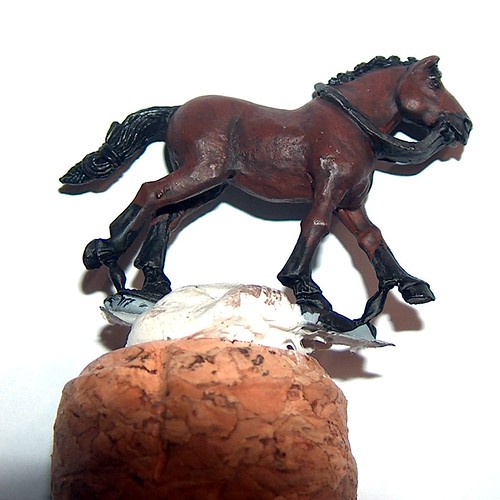Bart asked me to write up a piece on the army that I have built up for
Flames of War. So, here we are, and first, a few words on the game system. Flames of War is basically a company level game, with a design a little reminiscent of WHAB - simple basic mechanisms but lots of chrome and special rules to reflect specifics of individual armies. It works very well. The games are short, violent and often funny.
The rule-set is brilliantly supported by Battlefront, the publisher. It produces the figures (very nice quality 15mm) and armour (the models are made from a mix of resin and metal), packaged in platoon or company packs, with the bases you need and painting guides. The website gives a lot more background, including profiles of different units, guides to putting together the models, lots of photos of painted miniatures, etc. - all extremely useful. They have also worked with
Vallejo to provide sets of suitable paints, which again is pretty helpful.
Some might complain that this approach makes it too easy, or takes the fun out of building the army. In a way, this is true, but you have to acknowledge that it is a winning method and will certainly be instrumental in attracting people to historical wargames. You can now buy, effectively, a box with rules, army organisation and lists, paints and a painting guide.
In the same way as WHAB uses 2000 points armies, DBM uses 400 points armies etc., FOW has a system of army lists (those who are allergic to lists can simply use them as a helpful guide to putting scenarios together) that provide for 1500 point armies that slug it out over a 6x4 foot (2x1.2 m) table. The game system currently supports three theatres of war:
- Russian front 1942-3
- North Africa
- 1944 Western Front.
For each theatre, there are a series of gamebooks listing the available armies. Each army has its own characteristics and special rules. I have always wanted a Soviet army, having a slight soft spot I suppose for the command economy and dialectical materialism, so the choice was easy.
Having selected the country, what sort of army? The army list books define different types of company - an infantry company, an armoured company or a reconnaissance company for example. I personally think that if you're playing WW2, you better have tanks, so I decided to build a soviet armoured unit.
The soviets in FOW are characterised, not unreasonably, as 'conscript (ie cheap, difficult to control, very vulnerable) but fearless (easy to rally even when taking casualties). This means you get vast numbers of them - where for a German army you have a company, for a soviet army you have nearly a battalion, but they are pretty unmanoeuverable and are very inflexible. For instance, a German panzer can dance rings around them, can move, shoot and then, potentially move again. A soviet tank can barely move and fire in the same turn, which is very limiting.
The heart of the army is two tank companies and of course, the T34 provides the backbone. I have one company of 7 T34s plus a company of 6 T70 light tanks. These latter are quite pretty and fast, but very vulnerable to enemy fire, having little armour to speak of.
 T34s
T34s
Originally uploaded by ahuyton.
To back these up, are tank riding infantry with supporting machine guns plus a medium mortar company (these are cheap and very effective in the rules). Additional options that I have available, are heavy KV1 tanks (brutal things), Katyushas (fun but vulnerable - enemy artillery can automatically home in on them if the Katyushas fire), BA64 armoured cars, anti tank rifles and heavy mortars.
 Katyushas
Katyushas
Originally uploaded by ahuyton.
Overall, I think, my favourite selection is:
* A Cin C with supporting AA machine guns
* A company of T34s, to provide a fast and reasonably hard hitting shock weapon
* A company of T70s, cheaply bought and handy backup to the other tanks
* A company of 3 KV1e, which even German tanks find difficult to shoot up.
* One platoon of infantry + mg to seize woods, buildings etc
* A medium mortar platoon plus spotter to try to pin enemy infantry or guns
* A reconnaissance unit of light armoured cars, which I think serves little purpose, but I think they're quite fun little models.
I have played three games with them, and lost each one, they are really quite difficult to control. At least that's my excuse.
I can unreservedly recommend the system and everything that goes with it, it has all the elements of a good,well thought out system that works and is properly supported. For the Belgian readers,
L'Antre Jeux in Brussels sells all the stuff, including all the paints.
I now have 3000 points worth of Soviets, enough to start varied scenario games as well as giving me different options in the tournaments style games (yes there is a FOW tournament scene). Next, I want to paint up an opponent for them, and have decided, perhaps perversely, to go for a Finnish army - a very different affair. Elite troops, so few in number and with little armour to speak of. I hope it will make for an interesting match up.
_Update_ (robartes): added some formatting, removed big white space after first photo






